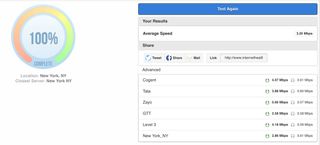I hated Time Warner Cable, but I came back for Spectrum
Verizon's failure to roll out its fastest home internet led me to discover that you can teach an old ISP (Time Warner Cable) new tricks.
Going back to your ex can be a humbling experience, especially when you're not sure if they've changed their ways. Such was the case when I thought I had left bad home internet behind by leaving Time Warner Cable for Verizon and DirecTV. Unfortunately, the latter pair combined for inferior home internet and satellite television, so I had to bite the bullet and call up Time Warner Cable to see what it had to offer.

It all started when I became a Time Warner Cable customer, before it became known as Spectrum (Charter purchased and renamed it). For years, I suffered the consequences of this decision, including dozens of frustrating technical support calls when the company's internet and cable services frequently went on the fritz, creating an experience as reliably chaotic as Sean Spicer's press briefings.
Eventually, the service outages became too frequent to bear, and I switched to DirecTV and Verizon, back when the former wasn't owned by AT&T and the latter offered a discounted package.
DirecTV and Verizon failed me
Of course, since nothing good lasts forever, I realized a year ago that both Verizon and DirecTV were doing me dirty. Once my roommates and I added a second TV to the apartment, we discovered our bandwidth wasn't fast enough to deliver two simultaneous streams. So we began negotiations and discussions about who needed to stream what, and when.
And then, one night at a friend's loft, I found out that one of my favorite channels (director Robert Rodriguez's El Rey Network) was available in HD via Time Warner. I had just assumed that wasn't the case because the big, mighty DirecTV was delivering it in grainy, stretched-out standard definition.

I contacted both DirecTV and Verizon about these issues, and the early results were not good. DirecTV's contract with El Rey (and other channels) didn't include HD, and Verizon told me that its highest-speed DSL was the best it could offer. Yes, I was using DSL and thought it was enough at some point. I was a fool.
On one call, a Verizon rep told me to call back about its faster FiOS in three months, when it would be ready. So I set a reminder on my smartphone and called on that exact day. Turns out, they told me the company's premium home internet was still not available in my area. I'm not alone in that regard, as the city of New York is suing Verizon for failing to meet its promised FiOS rollout date.
They've changed, they say
So, imagine my surprise as my friends and colleagues would tell me stories about how great Time Warner was treating them, and that it was now calling itself Spectrum. The moment went beyond shock, as I honestly didn't believe it.
Sometimes, your ex truly has changed.
But then, I did the math. According to the Internet Health Test, Verizon DSL was giving us a maximum download speed of 7 MBps and an upload speed of slightly less than 1 MBps. Yeah, that’s really slow. Then, I talked to a few friends with Time Warner/Spectrum, and asked them to run the same test.

They returned screengrabs showing download speeds averaging 95 MBps and upload speeds around 7 MBps.

And that was the moment I realized that Verizon might have been robbing me blind.
Convincing my roommates
I proceeded to talk to my roommates, whose memories of Time Warner were just as bad as my own, about switching back. They were hesitant, saying things such as "Don't you remember how bad it was?" and "They were so bad at fixing our service!"
I didn't get the go-ahead from my roommates until I explained that there was a 30-day money-back guarantee. Translation: We weren't committing blindly.
So I didn't press the issue. Or at least I wasn't going to, until a friend visiting me couldn't load a web page fast enough over my home Wi-Fi. My friend, aghast, asked, "What's wrong with your internet?" It turned out that my PS4 was downloading a game update in the background, which ate up every bit of bandwidth.
Ashamed, I later told my roommates this story, and about the potential upside. They weren't interested until I showed them that phone, internet and cable from Time Warner would cost around $80 less per month than we were currently spending. I didn't get the go-ahead, though, until I explained that there was a 30-day money-back guarantee, so we weren't committing blindly.
I have not recommended that we use Spectrum Streaming, the paltry $14.99 streaming service that the company keeps trying to sell my cord-cutting colleagues on.
A deep sigh of relief
I'll remember Thursday, March 23, 2017 as clear as ever, as that was when our household finally got the high-speed internet everyone deserves. That night, as a test, I set up four concurrent high-def video streams, and I saw not a single hiccup.
Now, I can leave my PS4 in rest mode day and night, so I won't boot it up to find out a 7GB file needs to be downloaded before I can play more Persona 5 or Uncharted 4.
Over on the TV side, Time Warner's lineup stayed true to what we expected, giving us all the channels we want in HD. I’m delighted to say I don't think I've seen any standard-definition programming on that screen since that day.
Furthermore, the Time Warner/Spectrum reps I have talked to and who have installed services in our apartment were the nicest customer service agents I've ever worked with. They certainly trump DirecTV's installation rep, who had me sit in his car to prevent a parking ticket (long story), and its retention employee, who pushed me to explain every issue I had with the service when I called to cancel.
So, learn from me, dear reader. Do not settle for substandard internet speeds and grainy low-res television. Sometimes, your ex truly has changed.
Sign up to get the BEST of Tom’s Guide direct to your inbox.
Upgrade your life with a daily dose of the biggest tech news, lifestyle hacks and our curated analysis. Be the first to know about cutting-edge gadgets and the hottest deals.

Henry is a managing editor at Tom’s Guide covering streaming media, laptops and all things Apple, reviewing devices and services for the past seven years. Prior to joining Tom's Guide, he reviewed software and hardware for TechRadar Pro, and interviewed artists for Patek Philippe International Magazine. He's also covered the wild world of professional wrestling for Cageside Seats, interviewing athletes and other industry veterans.
